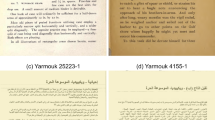Abstract
In this paper, we propose a new framework for architecture prototyping via the concept of 3D collage, that is, a combination of geometrically transformed components segmented from multiple source architectures. In short, our proposed framework makes its contribution by featuring three desired functionalities as follows. First, during the construction process, two components can be snapped together through the most matched faces. Second, deformation can be performed arbitrarily on any face of the resulting mesh. Third, the assignment of color and texture attributes on the resulting mesh is intuitively and flexibly done in a user-friendly manner. By enjoying a simpler user interface, our system strikes a good balance between efficiency and expressiveness, thus making it particularly appropriate for the purpose of rapid architecture prototyping. Results are shown to demonstrate that our framework is not only good at simulating a wide variety of existing architectures, but also capable of creating even avant-garde architectural styles.















Similar content being viewed by others
References
Besl P, McKay N (1992) A method for registration of 3-D shapes. IEEE Trans Pattern Anal Mach Intell 14(2):239–256
Cabral M, Lefebvre S, Dachsbacher C, Drettakis G (2009) Structure-preserving reshape for textured architectural scenes. Comput Graph Forum 28(2):469–480
Catmull E, Clark J (1978) Recursively generated b-spline surfaces on arbitrary topological meshes. Computer-Aided Design 10(6):350–355
Chomsky N (1956) Three models for the description of language. IRE Trans Inf Theory 2:113–124
Debevec P, Taylor C, Malik J (1996) Modeling and rendering architecture from photographs: a hybrid geometry and image-based approach. In: SIGGRAPH ’1996, pp 11–20
Efros AA, Freeman WT (2001) Image quilting for texture synthesis and transfer. In: SIGGRAPH ’2001, pp 341–346
Efros AA, Leung T (1999) Texture synthesis by non-parametric sampling. In: International conference on computer vision, pp 1033–1038
Ehrig H, Engels G, Kreowski H-J, Rozenberg G (1999) Handbook of graph grammars and computing by graph transformation: applications, languages and tools. World Scientific Publishing Company
Foley JD, vanDam A, Feiner SK, Hughes JF, Phillips RL (1990) Computer graphics: principles and practice. Addison-Wesley Publishing Company, 2nd edn
Funkhouser T, Kazhdan M, Shilane P, Min P, Kiefer W, Tal A, Rusinkiewicz S, Dobkin D (2004) Modeling by example. In: SIGGRAPH ’2004
Huang X, Fu H, Au OK, Tai C (2007) Optimal boundaries for poisson mesh merging. In: Symposium on solid and physical modeling, pp 35–40
Jin X, Lin J, Wang CCL, Feng J, Sun H (2006) Mesh fusion using functional blending on topologically incompatible sections. Vis Comput 22(4):266–275
Knuth D (1968) Semantics of context-free languages. Math Syst Theory 2 2(2):127–145
Lin J, Jin X, Wang CCL, Hui K (2008) Mesh composition on models with arbitrary boundary topology. IEEE Trans Vis Comput Graph 14(3):653–665
Lipp M, Wonka P, Wimmer M (2008) Interactive visual editing of grammars for procedural architecture. ACM Trans Graph 27(3):1–10. doi:10.1145/1360612.1360701
Merrell P, Manocha D (2008) Continuous model synthesis. ACM Trans Graph 27(5)1–7. doi:10.1145/1409060.1409111
Muller P, Wonka P, Haegler S, Ulmer A, Gool LV (2006) Procedural modeling of buildings. ACM Trans Graph 25(3):614–623
Muller P, Zeng G, Wonka P, Gool LV (2007) Image-based procedural modeling of facades. ACM Trans Graph 26(3). doi:10.1145/1276377.1276484
Parish YIH, Muller P (2001) Procedural modeling of cities. In: SIGGRAPH ’2001, pp 301–308
Paul M (2007) Example-based model synthesis. In: I3D ’2007
Piegl L, Tiller W (1995–1997) The NURB book. Springer-Verlag, 2nd edn
Sederberg TW, Parry SR (1986) Free-form deformation of solid geometric models. In: SIGGRAPH ’1986, pp 151–160
Sharf A, Blumenkrants M, Shamir A, Cohen-Or D (2006) SnapPaste: an interactive technique for easy mesh composition. Vis Comput 22(9):835–844
Sipser M (1996) Introduction to the theory of computation. Course Technology, Boston
Stiny G (1975) Pictorial and formal aspects of shape and shape grammars. Birkhauser Verlag, Basel
Wei L, Levoy M (2000) Fast texture synthesis using tree-structured vector quantization. In: SIGGRAPH ’2000, pp 479–488
Wonka P, Wimmer M, Sillion F, Ribarsky W (2003) Instant architecture. ACM Trans Graph 22(3):669–677
Xiao J, Fang T, Tan P, Zhao P, Ofek E, Quan L (2008) Image-based facade modeling. ACM Trans Graph 27(5):1–10
Author information
Authors and Affiliations
Corresponding author
Rights and permissions
About this article
Cite this article
Yang, CK., Tsai, CY. Fast architecture prototyping through 3D collage. Multimed Tools Appl 57, 527–547 (2012). https://doi.org/10.1007/s11042-010-0654-4
Published:
Issue Date:
DOI: https://doi.org/10.1007/s11042-010-0654-4




